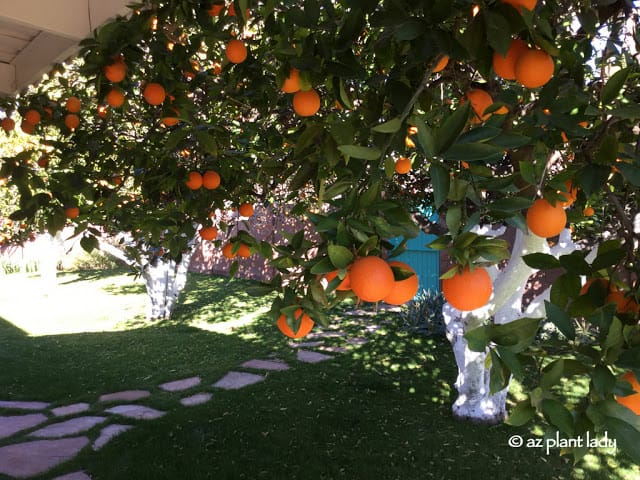
In the Desert Southwest, we are fortunate to be able to grow citrus. In early fall, your citrus tree probably looks like the one pictured, with green fruit that is getting ready to ripen in this winter.
It is time for the third fertilizer application to your citrus trees if you have not already done so. Mature citrus trees require three applications of fertilizer – around Valentine’s Day, Memorial Day and Labor Day.
Citrus trees require nitrogen more than any other nutrient. I recommend using a granular fertilizer specially formulated for citrus because, in addition to nitrogen, they also contain micronutrients, (iron, zinc, manganese), that are vital to the health of your citrus tree. Citrus fertilizer spikes are also an option.
If you choose to use only organic fertilizer for your citrus, there are some natural products available, or you can use composted cow manure, working it into the top few inches of soil and watering it in afterward.
GENERAL GUIDELINES:
– Fertilizer should not be applied to newly planted trees – wait until they have been in the ground for one year.
– Water the soil around the tree before and after you apply fertilizer.
– Follow the directions on the fertilizer bag. Be sure that you divide by three the annual amount of fertilizer needed by your tree – do not apply all at once!
– When in doubt, apply slightly less fertilizer then you think you need. You don’t want to over-fertilize and end up with fertilizer burn. Smaller trees require less fertilizer than larger trees.
– Apply granular fertilizer around the perimeter of the tree, extending just past the drip line. Work into the top few inches of soil.
– Do not apply a foliar fertilizer when air temperatures are 85 degrees F or above because there is a danger of burning the foliage.
– For mature Grapefruit trees, (over six years old), apply only 1/2 the amount of fertilizer recommended on the fertilizer label because high amounts of nitrogen promote a thick rind (peel).
Get ready to enjoy the fruits of your labors this winter and get ready for March when we will discuss the correct way to prune and plant citrus.
Iconic Desert Tree, The Palo Verde








